|
|
Newsletter July 2022 | Menu of Newsletters
| |
 |
|
Give us your Challenge
|
Pricing |
Get a Quote |


Spectrometer Isolation: Growth of Large
Crystals for
Field-Portable Gamma Ray Spectrometers
"We are located in a
basement. I could actually see somebody walking down the stairs through the
walls with a seismometer. With the NSM Negative-Stiffness-Mechanisom system in
place, I can't even tell when they are shelling at the nearby Fort Riley
military base.".
|
|
December 2011 Legacy Article: At Kansas
State University, a facility is dedicated to the research and development of
new and innovative radiation detector technologies. The Semiconductor Materials
and Radiological Technologies (SMART) Laboratory is the largest
university-based radiation detection laboratory in the country. It focuses on
the detection of neutrons and gamma-rays, primarily those from special nuclear
material (SNM) for homeland security applications. SMART Lab investigates and
fabricates a variety of detectors which include compact low-power neutron
detectors, high-resolution room-temperature-operated semiconductor gamma ray
spectrometers, pixelated devices for gamma ray or neutron imaging, and
miniaturised gas-filled detectors. The laboratory builds detectors from start
to finish in readily deployable packages for use in better securing borders
from nuclear materials such as plutonium and uranium.
|
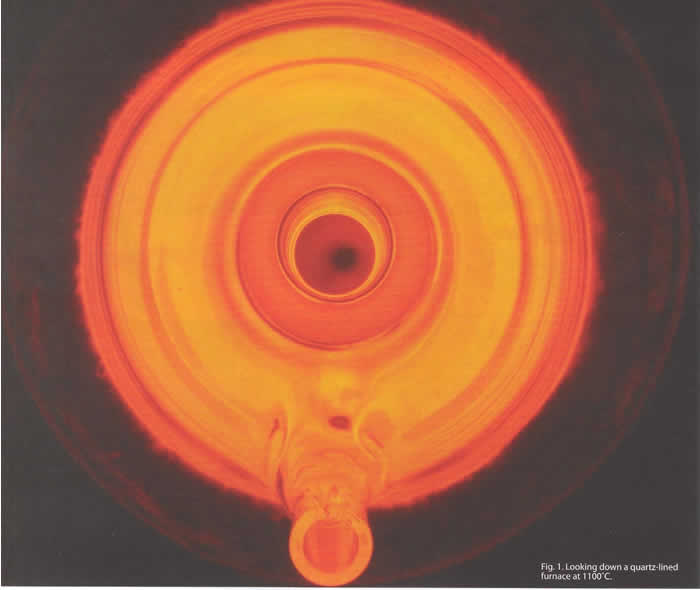
|
The gamma ray detection aspect of the
laboratory's research is focused on the discovery and development of new dense,
high-Z* semiconductor materials, such as cadmium zinc telluride (CdZnTe or CZT)
and mercuric iodide (HgI2), and several scintillator materials including
lanthanum tribromide (LaBr3) and cerium tribromide (CeBr3). Research conducted
on large crystal growth with high-Z semiconductor and scintillator materials
has produced large crystal ingot yields.
Gamma rays are electromagnetic
radiation of high frequency (very short wavelength), that are produced by
sub-atomic particle interactions such as electron-positron annihilation,
radioactive decay, fusion and fission. Gamma radiation is highly penetrating
photons, extremely energetic. To directly detect them is very difficult,
however - a material with a high Z number is needed, representing a high number
of neutrons and protons in the nucleus. Those nuclei tend to stop gamma rays
much better than other elements such as hydrogen or helium, for example. A
crystal with a high-Z number converts the gamma rays from electromagnetic waves
to excited electrons. The electrons move through the crystal or create light,
one or the other, and produce something that is possible to be detected. If a
crystal is very uniform, very homogeneous - it can be determined that a gamma
ray interacted in the crystal by the effect that is observed in it.
Growing giant crystals
At the SMART Laboratory, crystals of
CdZnTe and the scintillator materials are grown via a vertical Bridgman
furnace. In this process, molten material is directionally solidified from one
end to the other to produce a large-volume ingot that is a single crystal.
Methods to grow CdZnTe for gamma-ray spectrometers have been explored since the
early 1990s, yet a reliable system to produce large crystals at an economical
cost has not been achieved until relatively recently.
Higher ingot
yields enable smaller, faster and more accurate sensors, and allow gamma-ray
detectors to be more economical and field-portable - benefits that can have a
significant impact on national security objectives. Radiation detectors using
CZT can operate in direct-conversion (or photoconductive) mode at room
temperature.
Essentially, SMART Lab researchers encapsulate the material
to be grown inside of a quartz ampoule under vacuum. The quartz tube is put
inside the furnace vertically bringing the material to a molten state between
500° - 1100°C. Then they very slowly freeze the material from bottom to
top. If the thermal gradients are correctly performed, a large crystal will
develop. Once the crystal is grown, it is extracted from the tube, trimmed to
size with a diamond wire saw and polished to produce a
detector.
Vibration Isolation
Critical to maximizing ingot
yield is maintaining a stable crystal growth process through the elimination of
external vibrations.
|
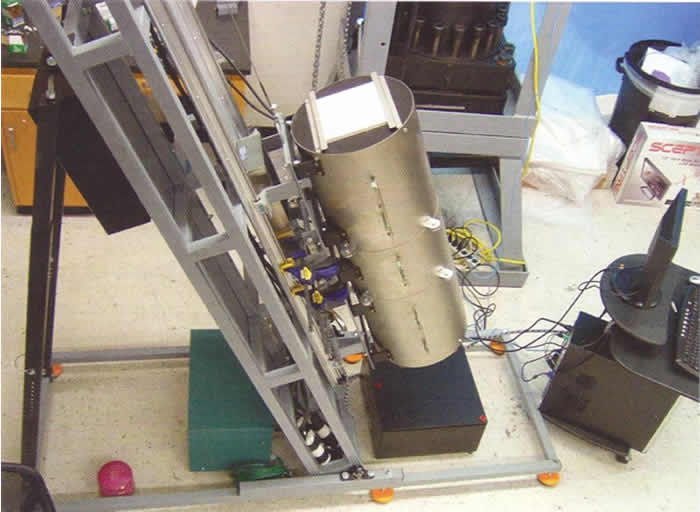
|
"The general consensus within the crystal growth
community is that uncontrolled vibrations can destabilize the growth
interface," says Professor Mark Harrison with SMART Lab. "As the material is
freezing from bottom to top, there is an interface between liquid and solid,
and it sets up a natural convection flow that is ideal for growing a big,
single crystal. If a vibration disturbs the liquid directly above the forming
crystal solid, it can change the convection patterns and multiple crystals will
form from the previous single crystal. Which is contrary to our purpose of
growing large, single crystals."
We looked into various active and air
table vibration handling systems, and eventually selected Negative-Stiffness
vibration isolation," continues Harrison..
Negative-stiffness mechanism
(NSM) isolators have the flexibility of custom tailoring
resonant frequencies vertically and horizontally. They employ a completely
mechanical concept in low-frequency vibration isolation. Vertical-motion
isolation is provided by a stiff spring that supports a weight load, combined
with a NSM. The net vertical stiffness is made very low without affecting the
static load-supporting capability of the spring.
Full article...
|
|
|
|
| |

 |
|
Give us your Challenge
|
Pricing |
Get a Quote |


NASA's ICESat-2 Spacecraft relies
with testing using Minus K vibration isolation
Inside a thermal vacuum chamber. No
electrical cords required.
|
|
NASA’S Ice, Cloud and Land Elevation
Satellite-2 (ICESat-2), which lifted off three years ago, has generated a
comprehensive portrait of the complexities of ice sheet change and insights
into the future of Greenland and Antarctica. The ICESat-2 measurements, when
compared to the measurements taken by the original ICESat from 2003 to 2009,
showed that in Antarctica the ice sheet is getting thicker in parts of the
continent's interior, likely as a result of increased snowfall. But the massive
loss of ice from the continent's margins (due to ocean warming) far outweighs
any small gains in the interior.
|
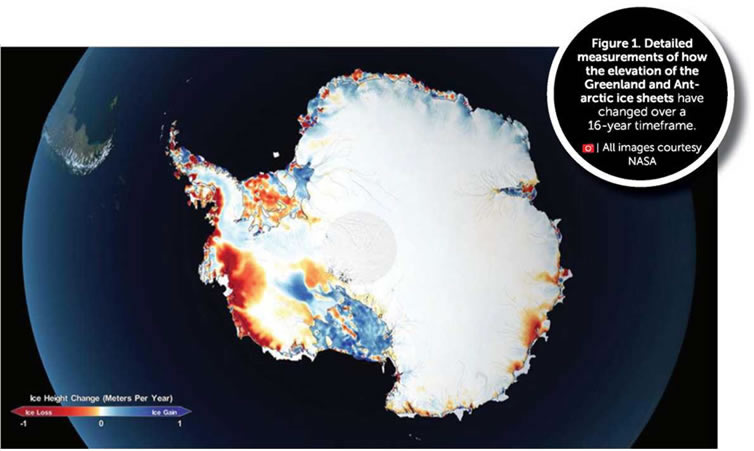
ICESat-2 will measure ice
heights in the polar regions
|
"The new analysis reveals the ice sheets'
response to changes in climate with unprecedented detail, revealing clues as to
why and how the ice sheets are reacting the way they are," said Alex Gardner, a
glaciologist at NASA's Jet Propulsion Laboratory."
This is one of the
first times that researchers have used laser altimetry to measure loss of the
floating ice shelves around Antarctica simultaneously with loss of the
continent's ice sheet. The researchers found ice shelves are losing mass in
West Antarctica, where many of the continent's fastest-moving glaciers are
located. Patterns of thinning over the ice shelves in West Antarctica show that
Thwaites and Crosson ice shelves have thinned the most, an average of about
16-ft and 10-ft of ice per year, respectively.
In this technique, AFM
tips or sharp needles can be employed to transfer small, femtoliter volumes of
molecular solutions, or other liquid-based ink, to predefined locations on the
surface of samples.
|
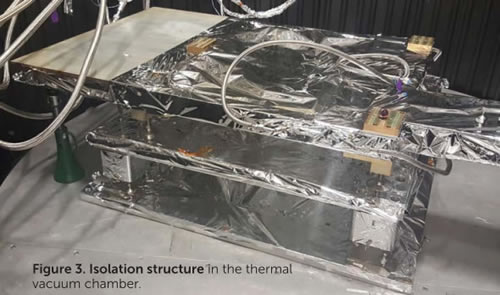
|
The vacuum chamber was configured with four
vacuum compatible Minus K 800CM-1CV negative-stiffness vibration
isolators to support the ATLAS instrument for the thermal vacuum testing. "The
Minus K isolators' primary use was inside the thermal chambers which did not
have as stable of a mounting surface as we would have liked," said Brian
Simpson, mechanical lead for ATLAS testing. "The isolators were critical in
cancelling out jitter introduced into our system by the facility."
Full article...
|
|
|

Sunken Treasure (2000 year old
Ancient Roman lead ingots)
Surrounding The Coldest Cubic Meter In The
Universe
Suspension of the cryostat uses
three Minus K Negative-Stiffness vibration isolators
Case Study |
|
November 2017 Legacy Article: The
Cryogenic Underground Observatory for Rare Events (CUORE) is a 1-ton scale
bolometric experiment that will examine a property of ghostly neutrinos by
looking for a phenomenon called neutrinoless double beta decay. Revealing this
process could be a clue as to why there is more matter than antimatter in the
universe and show that neutrinos get their mass in a way thats different from
all other particles.
Unlike ordinary beta decays, in which electrons and
antineutrinos share energy, the neutrinoless double beta decay produces two
electrons, but no neutrinos at all. It is as if the two antineutrinos that
should have been produced annihilate one another inside the nucleus.
|
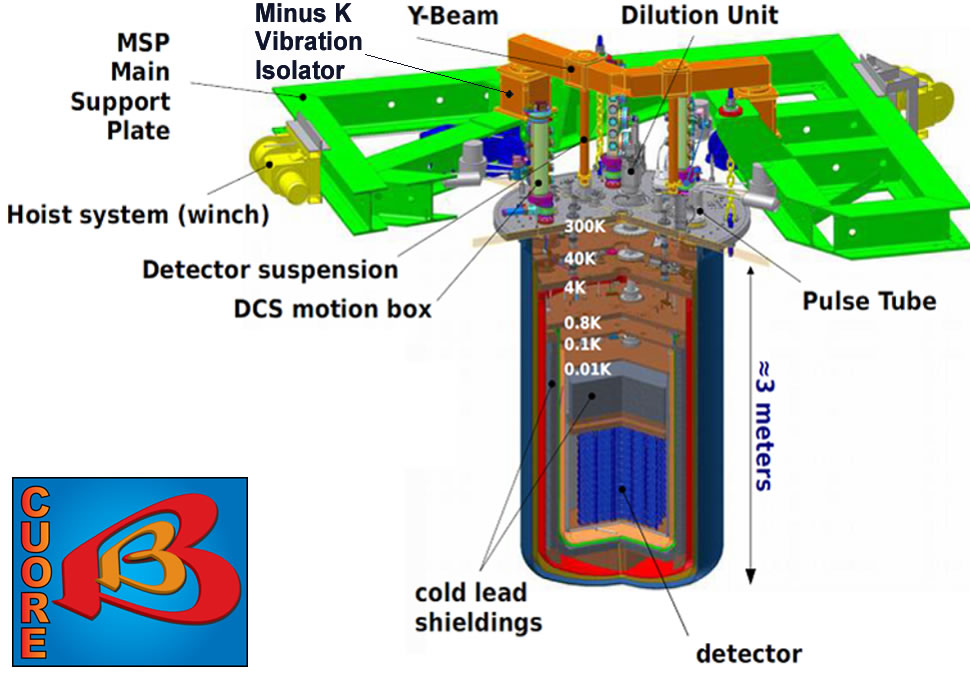
The Cryogenic Underground
Observatory Cryostat
|
The cryostat consists of six nested vessels and
shields. The three outermost ones are included in the outer Cryostat. Two of
them (300 K and 4 K) are vacuum tight: the space between the 300 K and 4 K
vessels constitutes the Outer Vacuum Chamber (OVC) of the cryostat and the 300
K vessel operates at room temperature. The volume inside the 4 K vessel
represents the Inner Vacuum Chamber (IVC) and in normal running condition this
vessel is thermalized to 4 K. Between the 300 K and 4 K vessel there is a
thermal radiation shield at 40 K covered with a multi-layer aluminized
superinsulation.
The entire cryostat is suspended from a heavy steel
support structure, Main Support Plate (MSP) which bears the load of close to 20
tons, specifically the detector (~1 ton), thermal shields and flanges (~8 tons)
and the internal lead shielding (~10 tons).
The detector suspension has
been designed to minimize the transmission of mechanical vibrations both due to
seismic noise and to the operation of cryocoolers and pumps. The suspension is
a two stage low-frequency isolator fixed to a Y-beam above the cryostat, in the
vertical direction, and a pendulum with a natural frequency of about 0.4Hz, in
the horizontal direction. It must provide load path for the detector while
minimizing the heat input and the vibration transmission.
The suspension
is made up of three Minus K Negative-Stiffness vibration isolators and
the Y-beam positioned on top of them which is mounted on top of the Main
Support Plate (MSP). The detector is suspended by the Ybeam through three
composite rods. The system formed by the Minus K isolators and the rest of the
detector will behave like a spring-mass system with a cut-off frequency of
0.5Hz. The composite rods are be made of several 316LN stainless steel rods,
with three copper thermal links connecting to 40K, 4K and Still plates. Also to
minimize vibrational noise of the detector as much as possible there are
independent suspensions for the vessels, dilution unit, and detector.
|
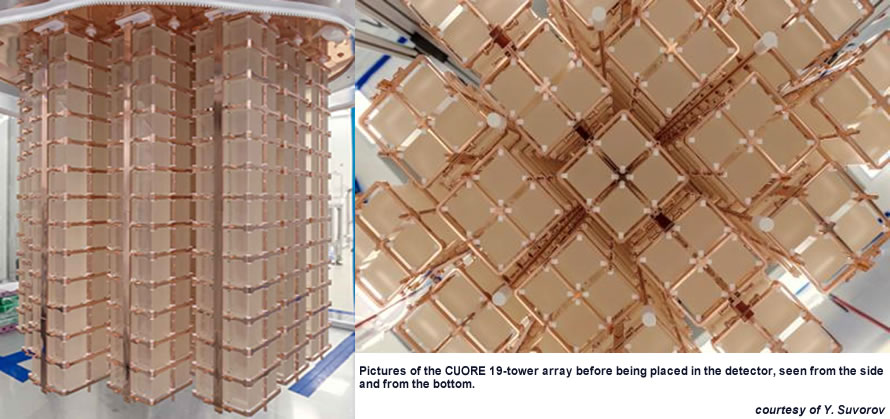
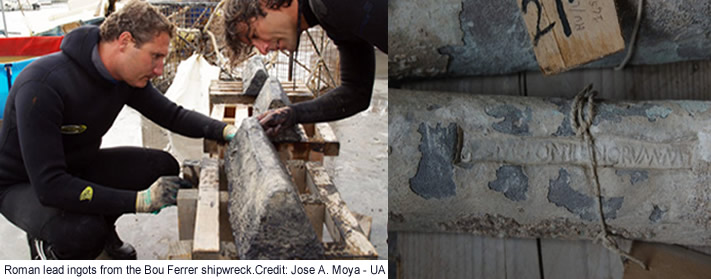
|
|
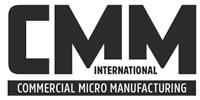
University of California
Merced Relies on
Negative Stiffness Vibration Isolator
from Minus K
Technology
For
accurate research into microscale friction
Case Study |
 | |
Feb.2022 -- Elizabeth Valero, Editor CMM
Magazine: Welcome to the first issue of 2022, which, it goes without
saying, we all hope will be a significantly more positive year than the
previous two. CMM has got off to a good start, with articles expected from new
as well as old faces in the coming months, and I like to think this Is a sign
of our continuance on the road back to normality.
First I thought I
might highlight a case study on how a negative-stiffness vibration isolator
from Minus-K Technology has enabled the School of Engineering at the University
of California Merced (UC Merced) to isolate environmental vibrations and thus
obtain precision microscale or, more specifically, micronewton friction
measurements The school has been using a linear-reciprocating microtribometer
to conduct valuable research into friction and wear on different material
surfaces subjected to various loading and sliding speed conditions. In order to
acquire measurements at (he micron level the microtribometer needs to be
isolated from environmental vibrations, particularly very low hertz vibrations,
these can be due to many factors from equipment and people inside the building
to vehicles and construction noise outside of it.
The negative-stiffness
vibration isolator replaced the vibration isolator the school initially used
for its research but that proved inadequate. This is because the
microtribometer demanded greater vibration Isolation for the measurement of
friction in micronewtons. The ability of the negative-stiffness vibration
isolator 1o achieve a significantly higher level of vibration isolation means
The researchers can be confident that the friction response measured is
attributable to the microtribometer's sliding contact. Moreover, they are able
to study materials that have much lower frictions.
|
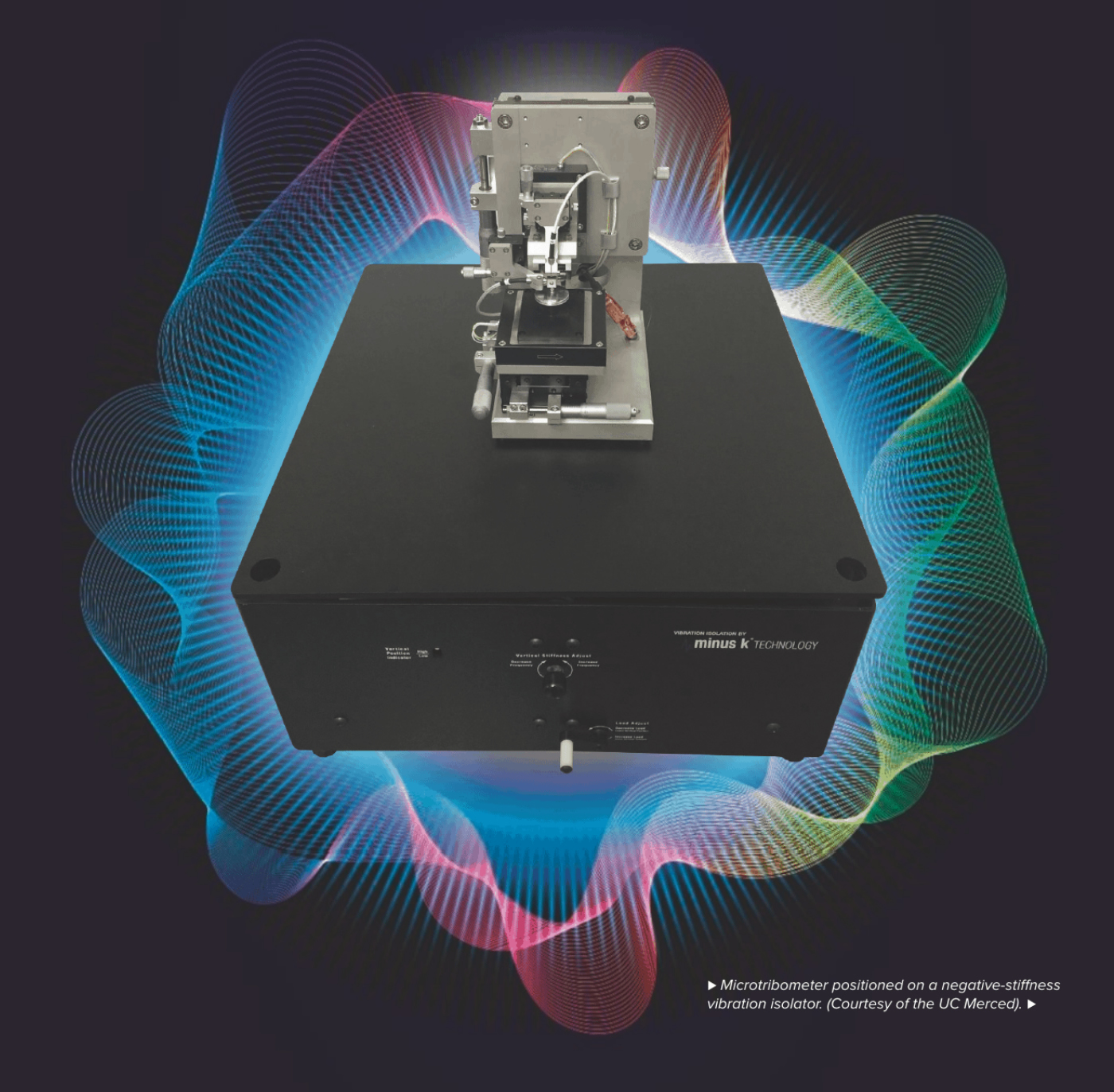
Microtribometer on a Miinus K
Negative Stiffness Vibration Isolator (Courtesy of the UC Merced)
|
The School of Engineering at the University of
California Merced (UC Merced) has been engaged In research focusing on
applications of microscale friction measurements to better understand
fundamental mechanisms underlying tribological phenomena. A critical end
fundamental component of the school's research Is the Isolation of
environmental vibrations utilizing a negative-stiffness vibration isolator from
Minus K Technology which has enabled precision measurements of friction at
micronewton magnitudes.
Whenever two surfaces are moving in contact with
each other their behavior is influenced by friction. Smooth surfaces, even
those polished lo a mirror finish, are not truly smooth on scales. They are
rough, with sharp or rugged projections referred to as
asperities.
Initially, the surfaces only touch at a few of these
asperity points which cover only a very small portion of the surface area.
Friction and wear originate at these points, so understanding their behavior
becomes important when studying materials in contact.
The measurement of
this fractional force between two surfaces is undertaken using a
microtriborneter This instrument measures quantities, such as coefficient of
friction and friction force between the two surfaces that are in contact These
measurements can relate to a number of types of important properties of
mechanical components, including energy efficiency.
The basic operation
of a microtribometer involves a flat of spherical surface that is moved
repetitively across the face of another material. An exact load is applied to
the moving part for the duration of the test. Equipment and methods used to
examine the surfaces before and after sliding include optical microscopes,
scanning electron microscopes, optical interferometers and mechanical roughness
testers. The final measurements show the wear on the material end are often
used to determine its strength and longevity.
The need for vibration
isolation
Microtribometer measurements at the micron level require
isolation from ambient environmental vibrations, particularly very low hertz
vibrations. Isolating a laboratory s sensitive instrumentation against
low-frequency vibrations has become increasingly more vital to maintaining
imaging quality and data Integrity.
|
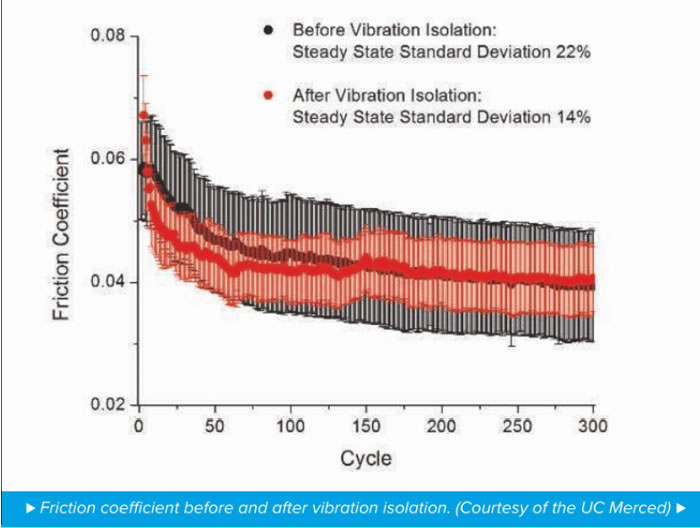
|
|

Negative-Stiffness Vibration
Isolation Aids Quantum Electronic Research
Single-Atom Flakes &
Quantum Electronics Vibration Isolation |
|
Better understanding the character and properties
of graphene, and similar two-dimensional materials, will advance their
integration into improvements for semiconductors, electronics, photovoltaics,
battery energy storage and many other applications.
One university laboratory that has been
conducting research with graphene and other atomically-thin materials for some
years is the Henriksen Research Group at Washington University in St. Louis,
Missouri.
Our experiments entail the careful measurement of the
electronic properties of thinly-layered materials, including both electronic
transport and thermodynamic quantities, such as the magnetization and
compressibility of electron gas, says Professor Erik Henriksen Ph.D., leading
professor of the Henriksen Research Group. We also conduct measurements of the
infrared absorption spectrum to probe the electronic structure directly.
The group searches for unusual and unexpected properties of
low-dimensional materials, utilizing a combination of electronic, optical and
thermodynamic measurement approaches to understand the novel quantum electronic
phases that arise. The experiments are generally conducted at very low
temperatures, fractions of a degree Kelvin above absolute zero, and in high
magnetic fields, employing custom devices made of graphene or related
crystals.
Single-Atom Flakes
We look at the physics of the
layered graphene, where the layers are weakly bound, so they can be pulled
apart, explains Henriksen. We isolate these very thin layers down to a single
atom. Then, lift the graphene flakes from bulk graphite with adhesive tape,
transferring them very carefully onto silicon wafers.
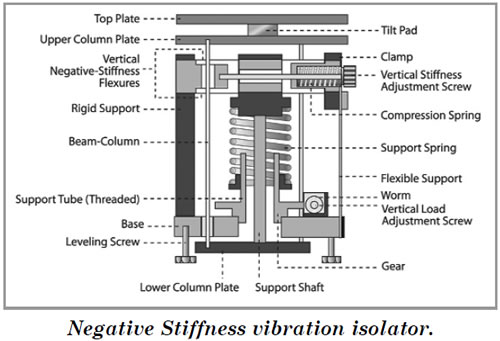
Full article...
|
|
|
In its continuing efforts to revolutionize
discovery-based research into complex biological systems, Pacific Biosciences
has released its next generation of automated, long-read genomic sequencer with
single molecule, real-time (SMRT) sequencing technology – the Sequel
System.
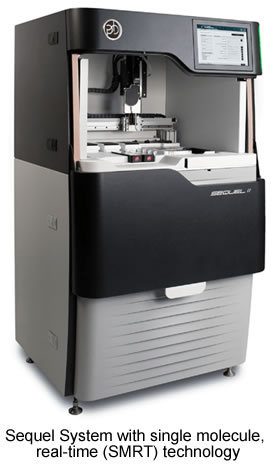
In its continuing efforts to revolutionize
discovery-based research into complex biological systems, Pacific Biosciences
has released its next generation of automated, long-read genomic sequencer with
single molecule, real-time (SMRT) sequencing technology – the Sequel
System.
The Sequel System is very multifaceted in operation, says Kevin
Lin, mechanical engineer at Pacific Biosciences. It encompasses robotics,
chemical and biological processing, and photonics. Because its intended to be
used in diverse settings within research and laboratory environments, excessive
ambient vibrations could negatively influence the data sets. So, we needed to
implement a vibration isolation component that not only isolated the sensitive
components from vibrations, but also was sufficiently small, compact, and
integrative.
Internal and external factors can create vibration issues
from buildings housing the system including heating and ventilation systems,
fans, pumps, elevators, adjacent road traffic, nearby construction, loud noise
from aircraft, and weather conditions. These influences cause vibrations as low
as 2Hz that can create strong disturbances in sensitive equipment.
With
our earlier sequencer model, we used air tables for vibration isolation, which,
for the most part, performed adequately, Lin says. But use of the Sequel System
in more diverse locations, where low-frequency vibrations may be present to a
greater or lesser degree, necessitated a vibration isolator that was compact
enough to fit into our much smaller Sequel System and could effectively cancel
out these low-frequency vibrations.
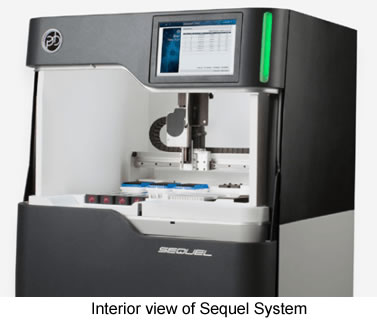
Negative-stiffness vibration
isolation
Pacific Biosciences ultimately decided on negative-stiffness
isolation to address their needs. Developed by Minus K Technology,
negative-stiffness isolators use completely passive mechanical technology for
low-frequency vibration isolation without using motors, pumps, or chambers,
making them zero maintenance. Because of their very high vibration isolation
efficiencies, particularly in the low frequencies, negative-stiffness vibration
isolation systems enable vibration- sensitive instruments, such as the Sequel
System, to operate in severe low-vibration environments that wouldnt be
practical with top-performance air tables and other vibration-mitigation
technologies...
Full article...
|
|
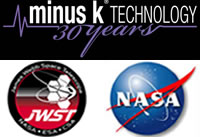
MInus K's Assist with the
Building of the JWST Telescope
|
|
All of the JWST systems-level cryogenic vacuum
tests were performed at the NASA Johnson Space Center’s (JSC) Chamber-A.
It is now the largest high-vacuum, cryogenic-optical test chamber in the
world, and made famous for testing the space capsules for NASA's Apollo
mission, with and without the mission crew. It is 55 feet (16.8 meters) in
diameter by 90 feet (27.4 meters) tall. The door weighs 40 tons and is opened
and closed hydraulically. The air in the chamber weighs 25 tons, when all the
air is removed the mass left inside will be the equivalent of half of a staple.
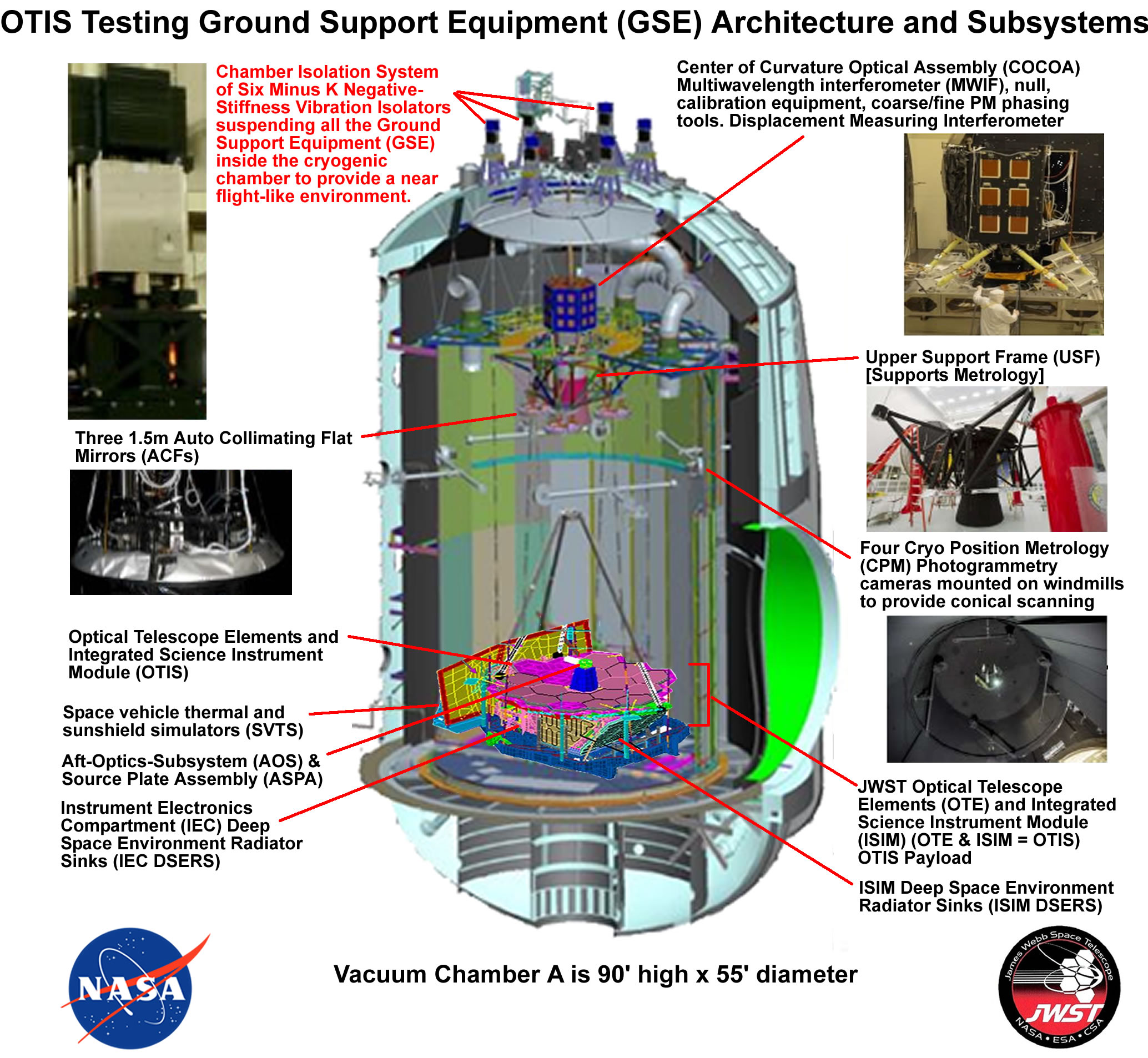
Diagram of the Cyrogenic Chamber in which the JWST
was tested for space.
For three years, NASA JSC engineers built and
remodeled the chambers interior for the temperature needed to test the James
Webb Space Telescope. Chamber A was retrofitted with the helium shroud, inboard
of the existing liquid-nitrogen shroud and is capable of dropping the chambers
temperature farther down than ever, which is 11 degrees above absolute zero (11
Kelvin, -439.9 Fahrenheit or -262.1 Celsius).
A key addition to Chamber
A was the addition of a set of six custom Minus K negative-stiffness
vibration isolators. The Minus K passive isolators do not require air and
offer better isolation than air and active isolation systems. A major factor in
the selection of the of the vibration isolators was that they not only isolate
vibration vertically, but also horizontally at less than 1 Hz.
JWST was
designed to work in space where the disturbances are highly controlled and only
come from the spacecraft, while on Earth with all the ground-based
disturbances, such as the pumps and motors, and even traffic driving by can
affect the testing. The Minus K vibration isolators provided dynamic isolation
from external vibration sources to create a near flight-like disturbance
environment.
The isolators utilize Minus K's patented Thermal
Responsive Element (TRE) compensator device, a passive mechanical device,
requiring no air or electricity just like the isolators. The TRE compensator
adjusted the isolators as the temperature changes throughout the testing at
JSC, keeping the JWST in the proper position.
The Critical Design Review
for Spacecraft-to-Optical Telescope Element vibration isolation system was
completed one month earlier than scheduled at the end of 2011. The six Minus K
negative-stiffness vibration isolators were installed on top of Johnson Space
Centers Thermal Vacuum Chamber A in March 2014.
JWST needed a support
structure inside the vacuum chamber to hold equipment for the testing.
Engineers installed a massive steel platform suspended from the six vibration
isolators via steel rods about 60 feet long (18.2 meters) each and about 1.5
inches (or 38.1 mm) in diameter, to hold the telescope and key pieces of test
equipment. The sophisticated optical telescope test equipment included an
interferometer, auto-collimating flat mirrors, and a system of photogrammetry
precision surveying cameras in precise relative alignment inside the chamber
while isolated from any sources of vibration, such as the flow of nitrogen and
helium inside the shroud plumbing and the rhythmic pulsing of vacuum
pumps.
Minus K's Involvement
continued...
-How much
farther can JWST see than the Hubble?
-Why was
it launched from near the equator?
-How cold
does the JWST get in space?
-How did
origami play into the trip?
-Why
24-karat gold on the mirrors?
Full article...
|
|
Our 29th
Anniversary is on 2/1/22
See the Milestones & Timeline
1993-2022
 | Founded in
1993 |  |
|
|
Minus
K Technology Opens

| |
Minus
K Technology opens for business in
February 1993 |
|
Minus K's original SM-1 patented
Negative-Stiffness passive vibration isolator. This was the first commercialy
available vibration isolator offering 0.5 Hz natural frequencies for both
vertically and horizontally. This was accomplished without the use of air
compressors, computer componets or electricity.
The isolator could be used alone, or in conjunction with other units, and
could be engineered directly into a system. | |
Original
SM-1 Vibration Isolator
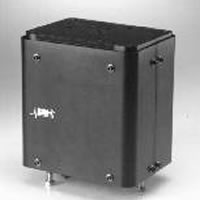 |
Our 29th
Anniversary is on 2/1/22
See the Milestones & Timeline
1993-2022

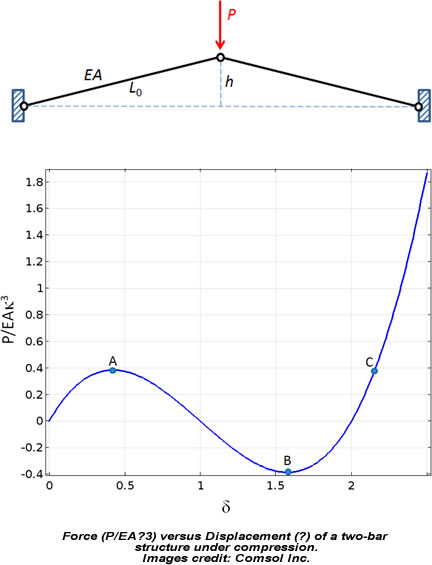
Notice that between points A and B, displacement is
increasing while force is decreasing. Thus, the structure’s stiffness is
negative in that region.
Negative-stiffness vibration isolators consist
of a horizontal isolator and a vertical isolator connected in series. To
counter motions that involve rotation (pitch and roll), a tilt motion pad can
also be connected in series with the horizontal and vertical isolators.
The horizontal isolator consists of two fixed-free vertical beams
(columns) supporting a weight. The weight imparts both eccentric (off-axis)
axial compressive load and a transverse bending load. This phenomenon is
referred to as the beam-column effect and causes the lateral bending stiffness
of the beams to decrease. In effect, the isolator is acting as a horizontal
spring with a negative-stiffness mechanism.
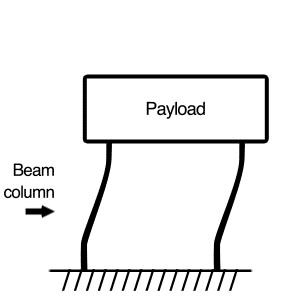
The horizontal isolator
is designed to take advantage of the beam-column effect, allowing it to act
like a negative-stiffness mechanism.
Vertical motion is addressed using two horizontal
flexures loaded in compression, which form a negative-stiffness mechanism. The
flexures are supported at their outer ends and connected to a stiff spring at
their inner ends. The stiffness of the isolator is determined by the design of
the flexures and by their compressive load.
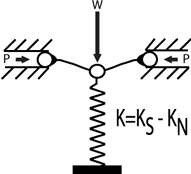
Two flexures, fixed at their outer ends and
connected to a spring at their inner ends, form a negative-stiffness mechanism
that isolates equipment from vertical motion due to vibrations.
Full article...
|
|
Press Release:
New Ultra-Thin
CT-2 Low-Frequency
Vibration Isolation Platform Adapts
to Space Constraints in Critical Micro-
and Nano-Microscopy
(replaces the CT-1)
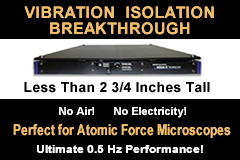

Full
release... |
|
|

 |
|
|
